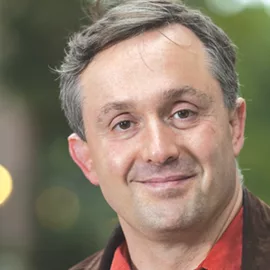
 By Stephen R Balzac
By Stephen R Balzac
Nov. 1, 2012
The classic movie, “Star Wars: A New Hope,” features a scene aboard the spaceship Millennium Falcon in which a blindfolded Luke Skywalker attempts to use a lightsaber to deflect energy bolts from a floating drone. This scene is presented to the viewer as a Jedi training exercise. As the old Jedi Master, Obi-Wan Kenobi, calmly instructs Luke to “trust the Force,” Luke attempts to feel the energy bolts before they arrive. Luke gets zapped frequently, to the vast amusement of Han Solo.
As Obi-Wan repeatedly exhorts Luke Skywalker to “trust the Force,” Luke eventually manages to successfully deflect a few of the energy blasts. This is an important step for Luke: In order for a Jedi to exercise their powers, they must be able to feel the Force and trust it. If they can’t trust the Force, all their tricks collapse like a cheap special effect.
Trust, the speed of trust, the importance of trust, and almost anything else that has anything to do with trust, gets a great deal of press in business books and articles. There is a good reason for this: For a team to function at its maximum capacity, the leader must be able to trust the members. Trust, however, cannot be one way — the members must also be able to trust the leader and to trust one another. Unfortunately, trust is not something we can just turn on or off at will. Just because we are told to trust someone, or told how important it is to trust someone, doesn’t mean that we can immediately do it. As with Luke Skywalker learning to trust the Force, it takes time and practice for trust to develop.
In a very real sense, trust and safety go hand in hand: When we don’t trust someone, we don’t feel safe around them and, conversely, when we don’t feel safe around someone we also don’t trust them. We tend to be more on our guard and less willing to engage. Commitment, innovation, feedback, and intelligent risk taking are sharply reduced. Careless risk taking, on the other hand, tends to increase.
Trust, it must be remembered, is a two way street. As your employees learn to trust you, you also learn to trust them. That means developing an accurate picture of their strengths and weaknesses. If you force people to operate in their areas of weakness, they will be more likely to fail. This reduces your trust in them and causes them to view you as setting them up for failure. That, in turn, reduces their trust in you.
Part of building trust is recognizing process. Every person in an organization tries to work in the ways they work best. Each person seeks to develop his or her own process. That process is, in a very real sense, a manifestation of who that person is in the organizational community. If you cannot trust someone’s process, you will not be able to trust them; conversely, if you do not trust someone’s process, they will not trust you — you are essentially telling them they cannot be who they are. When you trust someone’s process, however, you build trust in him or her and enable them to trust you. This increases productivity, motivation and loyalty. Fundamentally, as psychologist Tony Putman observed, a person becomes what he is treated as being. How you treat the process is how you treat the person.
So how do you learn to trust someone’s process?
Start by recognizing that trusting the process is not just about trusting that the results will be what you expect. That is important, but it’s a surprisingly small piece of the puzzle. There is no such thing as a perfect process and no process will always execute without something going wrong. True trust comes when you know that people can be trusted to handle mistakes and unpredictable events. Trust in our own skills comes from learning that we can make a mistake and recover; without that, trust is brittle. Trust in a process comes from recognizing that the process may sometimes give us the wrong answer, but it also gives us the ability to recognize that fact and recover.
The best approach is to start small. Your employees are feeling you out just as you are feeling them out. Don’t launch into something so large that you won’t be able to resist jumping in all the time to tell people what they should do. Rather, give people some degree of autonomy and safe space to experiment with their process for getting work done. Help them develop their process and be there for them when they make a mistake. In the practice of jujitsu, for students to develop expertise, they need the freedom to practice and screw up, and the freedom to then ask for help. If you punish people for making mistakes, you are demonstrating that they can’t ask for help and you are demonstrating that you don’t really trust their process.
To be a Jedi, Luke Skywalker had to work through the often painful and unpleasant process of learning to trust the Force. To be an effective leader, you will need to work through the often painful and unpleasant process of learning to trust your employees’ processes. No, it’s not easy and you won’t experience the immediate feedback of being able to block blaster bolts while blindfolded. Far too many leaders give up, dooming their teams to under performance. If you can succeed, though, the performance of your team will increase dramatically.
This article is drawn from Stephen Balzac’s upcoming book, “Organizational Psychology for Managers.” Balzac is an expert on leadership and organizational development. A consultant, author, and professional speaker, he is president of 7 Steps Ahead, an organizational development firm focused on helping businesses get unstuck. For more information, visit www.7stepsahead.com, or contact Balzac at [email protected].








